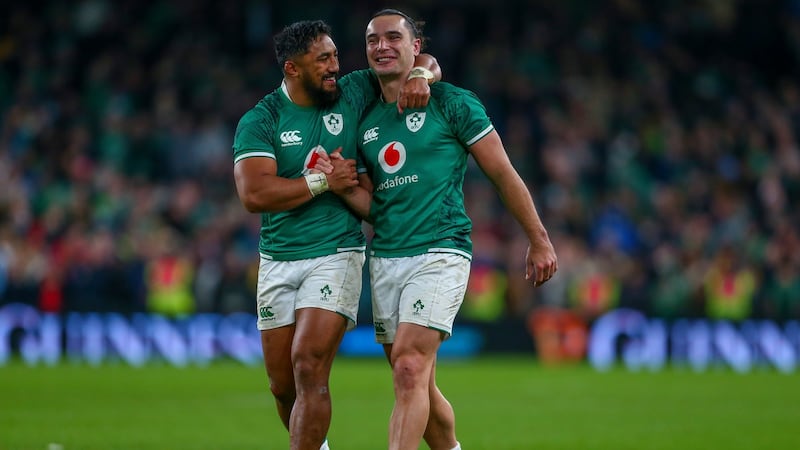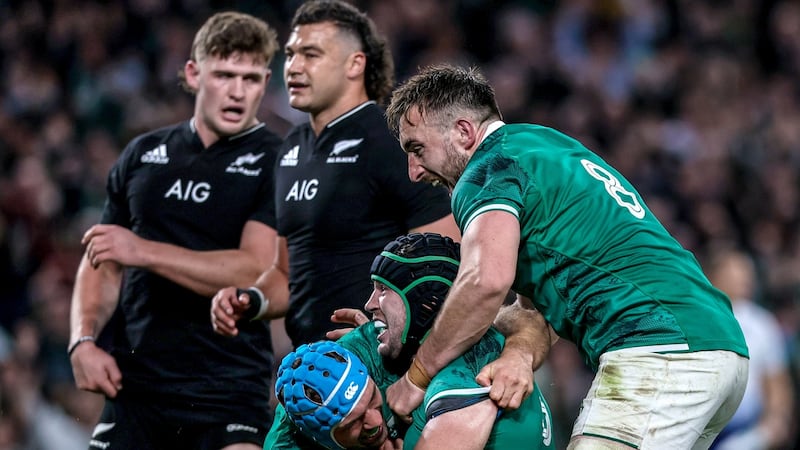In the build-up to Ireland’s magnificent win over the All Blacks on Saturday, the New Zealand press seemed to display a cautious trepidation that bordered on fear of a trip to Dublin.
In The Irish Times, New Zealand rugby writer Gregor Paul outlined his concern that losing in the Aviva would become a habit:
“Maybe the real reason this game is so important is that the All Blacks simply can’t afford to lose again in Dublin for fear that it may appear to be getting habitual.”
Scepticism remained though. Losing once in the Aviva in 2018 does not outline the start of a pattern.
Perhaps there is a journalistic fear of expressing overconfidence. Given teams’ ability to block outside chatter, this image is probably no longer relevant, but no writer wants to be the one who has their words pinned up on a changing-room door as motivational fodder.
It turns out though that Paul was on to something. Since the defeat on Saturday, other members of the New Zealand press have outlined their concerns that fortress Aviva is becoming an impenetrable stronghold for those in black jerseys.
Richard Knowler, a senior writer at stuff.co.nz, outlines this strange and novel caution that surrounds the Irish capital.
“Now we know it. Dublin remains a city where the All Blacks should fear to tread.
“Three years ago, when the Irish beat the All Blacks for the first time on home soil, they also delivered heavy blows to the tourists’ psyche by tackling themselves to a standstill and completely shutting down the slightest glimmer of light whenever it shone through the links in their defensive chain.
“This performance was better than their effort in 2018; the Irish wanted to attack, attack, attack by shifting the ball at speed from set phases, delivering quick passes in contact and it was no wonder that with 15 minutes still remaining that the All Blacks had already made more than 210 tackles.”

Despite this new-found fear, it is not as strong as that of the Irish when it comes to giving New Zealand any sniff of recovery. The scars of Ryan Crotty and Aaron Cruden in 2013 are still too raw – they probably always will be.
Writing for the New Zealand Herald, Liam Napier touches upon the cause of Ireland's All Black fears; their ruthless efficiency when it comes to capitalising on even the smallest of opportunities.
In a first half where Ireland dominated possession and territory, they only had James Lowe’s try to show for their efforts – Tadhg Furlong’s would-be score was chalked off after the TMO spotted a double movement from Rónan Kelleher.
New Zealand by contrast, had barely any entries into the Irish 22, but only needed one breakdown in communication between Furlong and Kelleher to burst through a gap in the defensive line and send Codie Taylor away.
For all of Ireland’s impressive attacking structure, the difference in scoring efficiency of the respective attacks at half-time was stark.
As Napier points out: “Such was their lack of possession, the All Blacks had only two genuine scoring chances in the first half. They clinically took one.
“The All Blacks were forced to absorb relentless pressure. Camped on their own line for extended periods as wave after wave of Ireland attack battered away, somehow the All Blacks held firm.
“The All Blacks managed a couple of moments of brilliance but they struggled to build any consistent pressure through phases, and when they review the tape it will show they were beaten in the collisions.
“They had no right to but the All Blacks led 10-5 at half-time despite spending almost the entire first half on the back foot defending their own line.”

Knowler goes on to make a very interesting point about Ireland’s coaching ticket. He draws a profound connection to a figure from Ireland’s past when dispensing credit for building the confidence required to turn winning against the All Blacks into a habit.
The 2019 World Cup disappointment may have unfairly tainted Joe Schmidt’s legacy for some but despite that, few can argue that Schmidt gave Irish rugby arguably its greatest ever gift.
Knowler continues: “Schmidt had left a powerful legacy; he had empowered Ireland to believe they could beat the All Blacks.
"The arrival of Englishman Andy Farrell as his replacement proves nothing has changed. If anything, the Irish have grown in belief.
“When Schmidt was in charge Ireland weren’t a team to take unnecessary risks. They played the percentages and when the time was right they struck.
“Ireland, in this victory, did much more than that.”
This reference to Ireland's attack which has clicked into gear in devastating fashion this autumn under Mike Catt is touched upon by many, with Knowler noting the aggressive ploy of turning down early shots at goal.
"Their willingness to spurn kickable penalties in the first half eventually resulted in their first try to Lowe – and they [the All Blacks] were later very lucky to have another to Tadhg Furlong ruled out because it was ruled Rónan Kelleher had illegally crawled with the ball earlier in the movement – and drained the fuel out of the All Blacks' tank."
Napier concurs, and even had time to give a shout-out to an iconic Irish backline move.
“Ireland played much more rugby than previous years and ultimately gained the rewards for doing so.
"The Jonathan Sexton wraparound remains a favoured pet play but with their dominance of possession, Ireland regularly chased width and often offloaded in contact."
For all this talk of Ireland's more ambitious game plan, Marc Hinton, also of stuff.co.nz, was not remotely surprised. Maybe he was watching against Japan last week, something which made him realise that an overly pragmatic Ireland was no more.
It’s safe to say he is also a touch concerned about what defeat means for this New Zealand outfit.
“Let’s give Ireland credit first. You can’t call it an ambush when you know it’s coming, and the New Zealanders went into this contest well aware of what was heading their way from a home side with its confidence and belief up.
“This was the second defeat for the All Blacks in 2021, and the first on this northern tour, and signalled loud and clear that there remains much to do over this World Cup cycle.”
It may be easy to forget due to him being restricted only to a cameo off the bench but this is the second time Peter O’Mahony had a major impact on a victory over the All Blacks at the Aviva, something which did not slip Knowler’s attention.
“Never underestimate the force of the Irish forward pack. Their set pieces were good, and their tireless efforts at the breakdown increased the pressure on the tourists.
“Perhaps inevitably it was Peter O’Mahony, a replacement backrower, who won a crucial penalty late in the game because in 2018 he also had a whale of a game against the All Blacks.”
We’ll leave the last word to Knowler, who summed up proceedings in a brutally honest way that makes for tough reading for any Kiwi.
"When referee Luke Pearce blew the final whistle, it was almost merciful. The All Blacks, having had to chase the game and forced to rush their execution, looked spent and exhausted."


















